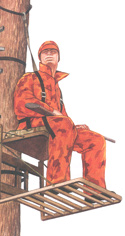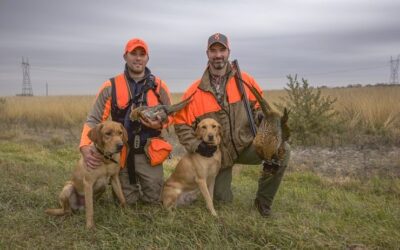Types of Tree Stands
The following is a description of some of the more well known types of tree stands:
- Fixed position stands – these stands are designed to be placed on a tree trunk and remain secured in that spot.
- Vertical ladder stands – this type of stand has a ladder that supports the shooting platform. The ladder is usually divided into short sections that can be assembled on site. The ladder “legs” extend at a slight angle out from the stand and tree trunk, and are secured to the trunk via supporting arms and belts.
- Climbing stands – the most popular stand type, the climber is designed to “walk” up a tree trunk with the hunter to a desired elevation.
- Permanent stands – such stands may be placed in a tree or cluster of trees and left there. They are exposed to weather and may deteriorate. Never trust the safety of a permanent tree stand that was built previously by someone else.
 Safety Harnesses
Safety Harnesses
- Always wear a safety harness, also known as a fall arrest system, when you are in a tree stand, as well as when climbing into or out of a tree stand.
- A safety strap should be attached to the tree to prevent you from falling more than 12 inches.
- In the event of a fall, harnesses provide some “cushion”, generally about four inches, which is the result of the alternately tightening and slipping of the harness as well as the normal stretch of the material.
- Always inspect the safety harness for signs of wear or damage before each use.
- Follow all manufacturers’ instructions for use of a safety harness and stand.
Recovery From a Fall
Preparation and prevention are the keys to safe tree stand use.
- In the event of a fall in a harness, try to recover as soon as possible. The longer you stay suspended from your harness, the harder it will be to recover from your fall.
- Seek suspension relief by grabbing onto the tree trunk or climbing steps.
- Take the weight off your harness as soon as possible.
- Once you have a firm hold on the trunk or climbing steps, use the 3 point rule to climb back into your stand or down from it.
- Replace your harness with a new on in the event of a fall, especially if you have cut your tree tether.
3 Point Rule
Follow the 3 Point Rule of tree stand safety. Always have 3 points of contact to the steps or ladder before moving. This could be two arms and one leg holding and stepping on the ladder or one arm and two legs in contact with the ladder before moving. Be cautious that rain, frost, ice or snow can cause steps to become extremely slippery. Check the security of the step before placing your weight on it.
 Safety Guidelines
Safety Guidelines
- Always use a haul line to pull up your gear and unloaded firearm or bow to your tree stand. Never climb with anything in your hands or on your back. Before descending, lower your equipment on the opposite side of the tree.
- Always select the proper tree for use with your tree stand. Select a live, straight tree that fits within the size limits recommended in your tree stand’s instructions.
- Always hunt with a plan, and if possible, with a buddy. Let others know your exact hunting location, when you plan to return and, who you are hunting with.
- Always carry emergency signal devices, such as a cell phone, whistle, walkie-talkie, signal flare and flashlight on your person at all times and within reach, even when you are suspended in your tree stand.
- The recommended height for an elevated tree stand is less than ten feet above the ground.
- Know your physical limitations. Don’t take chances. If you start thinking about how high you are, don’t go any higher.
- While climbing with a tree stand, make slow, even movements of no more than 10-12 inches at a time. Have proper contact with the tree and/or tree stand every time you move and follow the 3-point rule.
For a quick safety course that covers all aspects of tree stand safety, go to:
- www.huntercourse.com/treestandsafety (link is external)
For more tree stand safety information, go to:
- www.tmastands.com (link is external) or call 601-584-7983






0 Comments